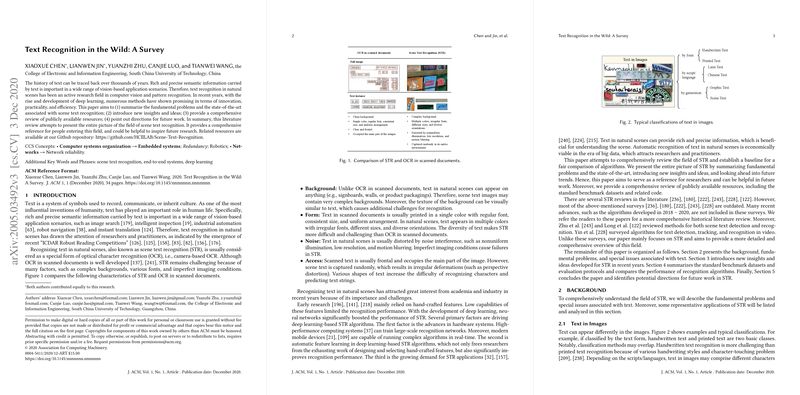Text Recognition in the Wild: A Survey
The paper "Text Recognition in the Wild: A Survey" by Chen et al. provides an extensive examination of the domain of scene text recognition (STR) within the field of computer vision. It highlights the significance of automated text recognition, especially in complex and varied natural scenes. This analysis covers fundamental challenges, methodologies, datasets, and future research directions.
Fundamental Challenges
STR is differentiated from traditional OCR by the variability and complexity of natural scenes. Key challenges include:
- Background Complexity: Unlike the clean background in scanned documents, scene text must be distinguished from heterogeneous and textured backgrounds.
- Diverse Fonts and Text Shapes: Scene text often varies in size, color, and orientation, complicating recognition processes.
- Noise and Distortion: Imperfect imaging conditions, such as blurring and low resolution, pose significant distractions.
Methodologies
The evolution of STR methodologies is marked by distinct phases:
- Segmentation-Based Methods: Early approaches relied on segmenting text into characters and employing hand-crafted features for recognition. These methods achieved limited success due to the intricate character segmentation problem.
- Segmentation-Free Methods: Modern algorithms avoid explicit character segmentation through sequence-to-sequence models utilizing deep learning architectures, notably Connectionist Temporal Classification (CTC) and attention mechanisms. The recent focus on robust rectification models further underscores the adaptability of these approaches to irregular text orientations.
Deep Learning Advancements
Deep learning has significantly enhanced the efficacy of STR. The incorporation of CNNs and RNNs has allowed for more robust feature extraction and sequence modeling, respectively. Moreover, the trend towards end-to-end systems—integrating detection and recognition—demonstrates a shift towards holistic text recognition systems with improved performance and efficiency. Despite these advancements, challenges in system integration and optimization persist, especially for complex text arrangements and multilingual settings.
Evaluation and Datasets
A comprehensive analysis of datasets reveals that synthetic data generation plays a crucial role in training data-intensive models. However, the evaluation of STR systems is complicated by variations in datasets and evaluation protocols. The paper highlights the necessity for standardized testing environments to ensure fair comparisons.
Implications and Future Directions
The survey underscores the importance of advancing STR in correspondence with practical applications such as intelligent transport systems and multimedia retrieval. It suggests exploring alternative methodologies, such as leveraging NLP to enhance capabilities. Additionally, the paper calls for further research on security implications and robust adversarial defenses.
Moreover, expanding STR capabilities for multilingual contexts and non-Latin scripts remains a high-priority direction, necessitating both algorithmic innovation and comprehensive multilingual datasets.
Conclusion
Chen et al. provide a detailed landscape of STR research, acknowledging both achievements and challenges. By scrutinizing methodologies and datasets, the paper serves as a critical resource for advancing research in the field. As STR technology continues to evolve, the theoretical and practical insights presented will guide researchers in addressing the field's open questions and unlocking its full potential.
